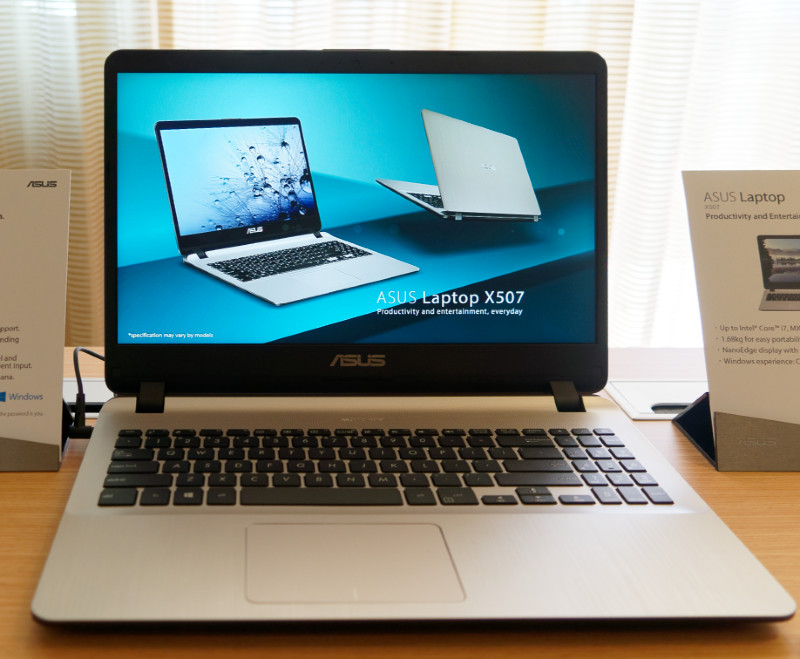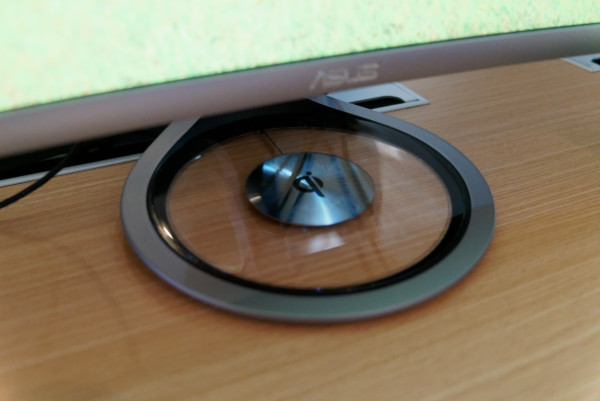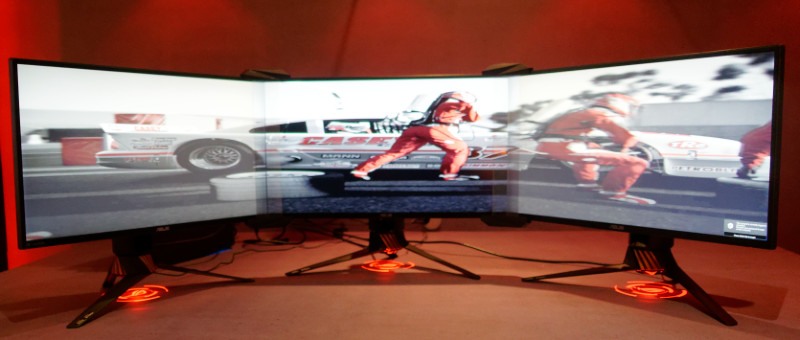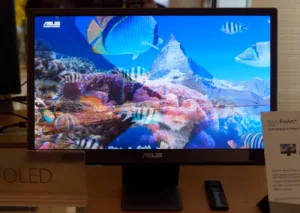Asus had a couple of suites in the Wynn, one covering just the ROG gaming products and the other covering the rest. We started in the main room looking at smartphones, PCs and monitors.
The X507 is a notebook that is a thin and light type with a 15.6″ display with slim bezels and 1366 x 768 or FullHD resolution. The system uses Core i3, i5 and i7 processors and the storage is a mixture of SSD and HDD. The weight is 1.68kg (3.7 lbs) but the battery has just a 33Wh capacity. Pricing is expected to be from $499.
 The Asus X507 is a value 15″ notebook. Image:Meko
The Asus X507 is a value 15″ notebook. Image:Meko
Moving up the range, we looked at the ZenBook 13 which uses processors up to a Gen 8 Core i7 processor (from i3) and with a FullHD or UltraHD screen (which has a touch option). It will cost from $999.
The NovaGo is a 360º design that is the Asus version of the Qualcomm/Windows 10S concept and with a FullHD glare screen. The notebook was announced in December (Vol 24 #47 Product Round Up) and will be available at the end of Q1 or Q2 at a target price of $599.
Next we looked at mobiles and the ZenFone Max Plus which has a 5.7″ 18:9 1440 x 720 LCD with 2.5 glass that is not from Corning. There is a bluelight filter. The phone uses an unspecified octacore processor with a Mali T860 GPU. Ram is 3GB or 4GB and storage is 32GB or 64GB with expansion via MicroSD. The main camera is a dual configuration with a 16 megapixel and secondary 8 megapixel 120º wide angle unit. The front camera is described as 8/16 megapixels. The dual SIM phone will sell in the US from February at $229.

After looking at these systems, we found someone that could tell us about the real novelty on the Asus booth, the 21.6″ ProArt PQ22UC, a new UltraHD monitor based on an OLED panel from JOLED and with UltraHD. The colour gamut is claimed to be 99% of DCI P3 and contrast is said to be one million to 1 and the monitor supports HDR. The panel is from JOLED and is made using ink jet printing to create an RGB architecture (no filter). The monitor is factory calibrated to give a delta E difference of “less than 2” and the panel is said to be a 10 bit unit.
The monitorcan be powered by USB Type-C and also has a micro-HDMI input. The aim is to exploit the low weight and small size of the OLED panel to make the monitor usable as an ‘out of the office’ monitor for those that need to work on images and video.
The Asus PQ22UC OLED is for those that need to work away from the office, but want great colour and contrast. Image:Meko
The next monitor we looked at was the Designo Curve, a 37.5″ 5840 x 1600 curved monitor with an IPS panel. Output is 300 cd/m² and contrast is 1,000:1 while response is quoted at 5ms G2G. Colour support is 100% of sRGB and connections include a DisplayPort 1.2 input and dual HDMI. Audio is enabled by dual 8W speakers from Harmon/Kardon. The monitor has a Qi wireless charging segment in the stand and will be available in the second half of the year at $1,099.
 The Asus Designo Curve has a Qi Wireless Charger in the base. Image:Meko
The Asus Designo Curve has a Qi Wireless Charger in the base. Image:Meko
Next we moved to a specialist ProArt monitor, the PA27AC 2560 x 1440 professional monitor that was also shown by VESA to demonstrate the quality of HDR400 monitors. The Asus unit uses Thunderbolt 3 to connect to a laptop and provides 45W of power to charge it. (VESA Enjoying DisplayPort Success) The company was also showing the 32″ UltraHD PA32U UltraHD monitor which puts power up to 60W and has 384 zones in the direct backlight and 1,000 cd/m² peak brightness. The monitor was announced last year at CES, but was late to ship, so CES 2018 was also a kind of launch. It will ship at the end of Q1 (which is when other 1,000 cd/m² sets will ship, so the delay was probably because of panel availability).
Turning to projection, the company had the F1, its first DLP-based projector for gaming. It has FullHD resolution with 1200 Ansi lumens. It has three speakers for 2.1 audio (2 x 3W + 5W woofer). Other details were hazy as the unit will not ship until the second half of 2018 when price will be decided.
 The Asus F1 Projector is intended for gaming. Image:Meko
The Asus F1 Projector is intended for gaming. Image:Meko
Next we looked at the gaming monitors. We started with the ROG Swift PG27UQ which is a UltraHD 27″ monitor with 144Hz with G-Sync that was announced last year, but was late shipping. The monitor has a QD film for wide colour gamut. Like the ProArt monitors, it has 384 zone backlight with 1,000 cd/m² and is, like the others of this brightness, delayed until the end of Q1.
In the ROG area, Asus had a three prism system that spread the images from the edge of adjacent monitors to dramatically reduced the visual impact of the bezels in gaming set ups. We thought that we wouldn’t want to use them for productivity, but for gaming they were good. They simply lay on the bezels and could be easily removed.
 Asus was playing with these triple monitor lenses to conceal the bezels! Image:Meko
Asus was playing with these triple monitor lenses to conceal the bezels! Image:Meko
Finally, we looked at the BFGD, but Asus couldn’t add anything to what we had learned from HP (The BFGD is Previewed by HP at CES).
Analyst Comment
At the moment, as it is still some way from delivery, Asus was reticence about quoting specifications for the 21.6″ OLED. It would also not be drawn on price or delivery. We found ourselves slightly disappointed with the image quality, but given the limited time, lack of a specialist display spokesman and no chance to try other content, it could have been the content or other conditions that meant that it was a little underwhelming. It will be interesting to see how good it is when we get close to shipping.

